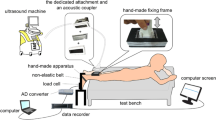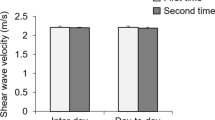Abstract
Objectives
The purpose of this study was to clarify, by use of sonographic elastography, the changes in elasticity of the masseter muscle after low-level continuous contraction by healthy volunteers.
Methods
The reproducibility of the elasticity index (EI) was verified by using a scoring phantom for elastography. The EI of the masseter muscle was measured for 10 healthy volunteers before, immediately after, and 10 min after static contraction at 20 % of the maximum force for 10 min. The masseter muscle thicknesses were also measured at these times as a surrogate index of muscle edema.
Results
The reproducibility of the EI measurements was sufficient for clinical use. The elasticity expressed by the EI increased after low-level contraction compared with that before contraction and changed similarly to the thickness along the time course of the experiment.
Conclusions
Low-level static contraction increased the elasticity and thickness of the masseter muscle. A potential relationship may exist between elasticity and edematous change in the masseter muscle.





Similar content being viewed by others
References
Olsson M, Lindqvist B. Mandibular function before orthodontic treatment. Eur J Orthod. 1992;14:61–8.
Gervais RO, Fitzsimmons GW, Thomas NR. Masseter and temporalis electromyographic activity in asymptomatic, subclinical, and temporomandibular joint dysfunction patients. Cranio. 1989;7:52–7.
Cooper BC, Cooper DL. Multidisciplinary approach to the differential diagnosis of facial, head and neck pain. J Prosthet Dent. 1991;66:72–8.
Flor H, Birbaumer N, Schulte W, Roos R. Stress-related electromyographic responses in patients with chronic temporomandibular pain. Pain. 1991;46:145–52.
Edwards RH. Hypotheses of peripheral and central mechanisms underlying occupational muscle pain and injury. Eur J Appl Physiol. 1988;57:275–81.
Jørgensen K, Fallentin N, Krogh-Lund C, Jensen B. Electromyography and fatigue during prolonged, low-level static contractions. Eur J Appl Physiol. 1988;57:316–21.
Ashina M, Bendtsen L, Jensen R, Sakai F, Olesen J. Muscle hardness in patients with chronic tension-type headache: relation to actual headache state. Pain. 1999;79:201–5.
Draper DO, Mahaffey C, Kaiser D, Eggett D, Jarmin J. Thermal ultrasound decreases tissue hardness of trigger points in upper trapezius muscles. Physiother Theory Pract. 2010;26:167–72.
Sejersted OM, Hargens AR, Kardel KR, Blom P, Jensen O, Hermansen L. Intramuscular fluid pressure during isometric contraction of human skeletal muscle. J Appl Phys. 1984;56:287–95.
Sjøgaard G, Savard G, Juel C. Muscle blood flow during isometric activity and its relation to muscle fatigue. Eur J Appl Physiol Occup Physiol. 1988;57:327–35.
Bakke M, Thomsen CE, Vilmann A, Soneda K, Farella M, Møller E. Ultrasonographic assessment of the swelling of the human masseter muscle after static and dynamic activity. Arch Oral Biol. 1966;41:133–40.
Sjøgaard G, Saltin B. Extra- and intracellular water spaces in muscles of man at rest and with dynamic exercise. Am J Physiol. 1982;243:271–80.
Ariji Y, Sakuma S, Kimura Y, Kawamata A, Toyama M, Kurita K, et al. Colour Doppler sonographic analysis of blood-flow velocity in the human facial artery and changes in masseter muscle thickness during low-level static contraction. Arch Oral Biol. 2001;46:1059–64.
Ariji Y, Taguchi A, Sakuma S, Miki M, Asawa T, Uchida K, et al. Magnetic resonance T2-weighted IDEAL water imaging for assessing changes in masseter muscles caused by low-level static contraction. Oral Surg Oral Med Oral Pathol Oral Radiol Endod. 2010;109:908–16.
Cagnie B, Dickx N, Peeters I, Tuytens J, Achten E, Cambier D, et al. The use of functional MRI to evaluate cervical flexor activity during different cervical flexion exercises. J Appl Physiol. 2008;104:230–5.
Larsen RG, Ringgaard S, Overgaard K. Localization and quantification of muscle damage by magnetic resonance imaging following step exercise in young women. Scand J Med Sci Sports. 2007;17:76–83.
Morvan D, Leroy-Willig A. Simultaneous measurements of diffusion and transverse relaxation in exercising skeletal muscle. Magn Reson Imaging. 1995;13:943–8.
Yanagisawa O, Niitsu M, Takahashi H, Goto K, Itai Y. Evaluations of cooling exercised muscle with MR imaging and 31P MR spectroscopy. Med Sci Sports Exerc. 2003;35:1517–23.
Burdette JH, Elster AD, Ricci PE. Acute cerebral infarction: quantification of spin-density and T2 shine-through phenomena on diffusion-weighted MR images. Radiology. 1999;212:333–9.
Ariji Y, Katsumata A, Hiraiwa Y, Izumi M, Sakuma S, Shimizu M, et al. Masseter muscle sonographic features as indices for evaluating efficacy of massage treatment. Oral Surg Oral Med Oral Pathol Oral Radiol Endod. 2010;110:517–26.
Ariji E, Ariji Y, Yoshiura K, Kimura S, Horinouchi Y, Kanda S. Ultrasonographic evaluation of inflammatory changes in the masseter muscle. Oral Surg Oral Med Oral Pathol Oral Radiol Endod. 1994;78:797–801.
Emshoff R, Bertram S. The short-term effect of stabilization-type splints on local cross-sectional dimensions of muscles of the head and neck. J Prosthet Dent. 1998;80:457–61.
Dighe M, Bae U, Richardson ML, Dubinsky TJ, Minoshima S, Kim Y. Differential diagnosis of thyroid nodules with US elastography using carotid artery pulsation. Radiology. 2008;248:662–9.
Lyshchik A, Higashi T, Asato R, Tanaka S, Ito J, Hiraoka M, et al. Cervical lymph node metastases: diagnosis at sonoelastography—initial experience. Radiology. 2007;243:258–67.
Alam F, Naito K, Horiguchi J, Fukuda H, Tachikake T, Ito K. Accuracy of sonographic elastography in the differential diagnosis of enlarged cervical lymph nodes: comparison with conventional B-mode sonography. AJR Am J Roentgenol. 2008;191:604–10.
Orbell JH, Smith A, Burnand KG, Waltham M. Imaging of deep vein thrombosis. Br J Surg. 2008;95:137–46.
Niitsu M, Michizaki A, Endo A, Takei H, Yanagisawa O. Muscle hardness measurement by using ultrasound elastography: a feasibility study. Acta Radiol. 2011;52:99–105.
Yanagisawa O, Niitsu M, Kurihara T, Fukubayashi T. Evaluation of human muscle hardness after dynamic exercise with ultrasound real-time tissue elastography: a feasibility study. Clin Radiol. 2011;66:815–9.
Lyshchik A, Higashi T, Asato R, Tanaka S, Ito J, Mai JJ, et al. Thyroid gland tumor diagnosis at US elastography. Radiology. 2005;237:202–11.
Ariji Y, Katsumata A, Hiraiwa Y, Izumi M, Iida Y, Goto M, et al. Use of sonographic elastography of the masseter muscles for optimizing massage pressure: a preliminary study. J Oral Rehabil. 2009;36:627–35.
Ariji Y, Katsumata A, Ogi N, Izumi M, Sakuma S, Iida Y, et al. An oral rehabilitation robot for massaging the masseter and temporal muscles: a preliminary report. Oral Radiol. 2009;25:53–9.
Itoh A, Ueno E, Tohno E, Kamma H, Takahashi H, Shiina T, et al. Breast disease: clinical application of US elastography for diagnosis. Radiology. 2006;239:341–50.
Acknowledgments
The authors thank all the volunteers for participating in this study. The authors also thank all of the radiologists and radiology technicians for their help with the examinations. This study was supported by a Grant-in-Aid for Scientific Research from The Ministry of Education, Culture, Sports, Science, and Technology (MEXT) (C) (23592785).
Conflict of interest
The authors declare that they have no conflict of interest.
Author information
Authors and Affiliations
Corresponding author
Rights and permissions
About this article
Cite this article
Gotoh, A., Ariji, Y., Hasegawa, T. et al. Sonographic elastography for assessing changes in masseter muscle elasticity after low-level static contraction. Oral Radiol 29, 140–145 (2013). https://doi.org/10.1007/s11282-012-0119-8
Received:
Accepted:
Published:
Issue Date:
DOI: https://doi.org/10.1007/s11282-012-0119-8




